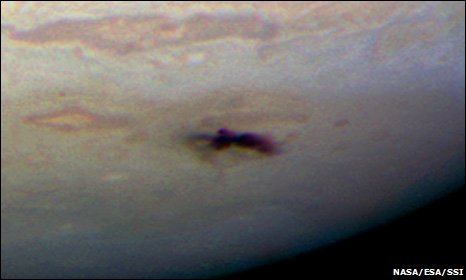
In astronomical terms, the collision happened relatively recently
A Nasa space telescope has found evidence of a high-speed collision between two burgeoning planets orbiting a young star. Astronomers say the cosmic smash-up is similar to the one that formed our Moon some four billion years ago, when a Mars-sized object crashed into Earth. In this case, two rocky bodies are thought to have slammed into one another in the last few thousand years. Details are to be published in the Astrophysical Journal. The collision involved one object that was at least as big as our Moon and another that was at least as big as Mercury. The impact destroyed the smaller body, vaporising huge amounts of rock and flinging plumes of hot lava into space. Infrared detectors on Nasa's Spitzer Space Telescope were able to pick up the signatures of the vaporised rock, along with fragments of hardened lava, known as tektites. Melted glass "This collision had to be huge and incredibly high-speed for rock to have been vaporised and melted," said lead author Carey M Lisse of the Johns Hopkins University Applied Physics Laboratory at Laurel in Maryland, US. "This is a really rare and short-lived event, critical in the formation of Earth-like planets and moons. We're lucky to have witnessed one not long after it happened." Dr Lisse and his team observed a star called HD 172555, which is about 12 million years old and situated about 100 light-years away in the far southern constellation Pavo (the Peacock). The astronomers used a spectrograph instrument on Spitzer to look for the fingerprints of chemicals in the spectrum of light from the star. The researchers identified large amounts of amorphous silica - melted glass. Silica can be found on Earth in obsidian rocks and tektites. Obsidian is black, shiny volcanic glass. Tektites are hardened chunks of lava thought to have formed when meteorites hit the Earth. Large quantities of orbiting silicon monoxide gas were also detected, created when much of the rock was vaporised. In addition, the astronomers found rocky rubble that was probably flung out from the planetary wreck. The two bodies must have been travelling at a speed of at least 10km/s (about 22,400mph) relative to one other before the collision.

Dark disturbance: the object that hit Jupiter left a scar
Rocky planets form and grow in size by colliding and sticking together. This process merges their cores and causes some of their surfaces to be shed. Though things have settled down in the Solar System today, impacts still occur, as was observed last month when a small comet or asteroid struck Jupiter. "The collision that formed our Moon would have been tremendous, enough to melt the surface of Earth," said co-author Geoff Bryden of Nasa's Jet Propulsion Laboratory (JPL) in Pasadena, California. "Debris from the collision most likely settled into a disc around Earth that eventually coalesced to make the Moon. This is about the same scale of impact we're seeing with Spitzer." "We don't know if a moon will form or not, but we know a large rocky body's surface was red hot, warped and melted." The Spitzer telescope has witnessed the dusty aftermath of large impacts before, but did not find evidence for rock that had been melted and vaporised. Instead, large amounts of dust, gravel, and boulder-sized rubble were observed, indicating collisions that were slower-paced.
|
Bookmark with:
What are these?